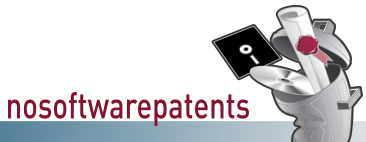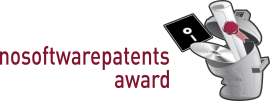| English | Deutsch |

![- Logo]](../images/layout007-small.png)
| Home |
| Software Patent of the year 2006 |
| About |
| Supporters |
| Background |
| News |
| Press November |
| Links |
| Contact |
| Imprint |
Press
In this section, the press is presented with up-to-date information about the nosoftwarepatents-award 2006 and other planned activities. We provide journalists with background insights as well as comments by experts and company representatives. Please contact: Harald Talarczyk, authentikom
info@nosoftwarepatents-award.com
Tel: +49 228 / 2804949
Fax: +49 228 / 2803250
Patent on context menu no software patent?
The patent on the context menu – according to Philips no software patent – is nominated for the election to be the "software patent of the year". Five current candidates can be elected in April, among them software patents of Microsoft and Fujitsu.
3 April 2006. According to Philips and the European Patent Office (EPO) the patent EP249293 on the so-called "pop-out-context-menu" is not a software patent. In contrast to this the patent has been
elected to be the "software patent of March" within the information campaign nosoftwarepatents-award which is
supported by 1&1, GMX, mySQL, Red Hat and CAS. As a result of
internet-votes it obtained a majority (57 %) and is consequently
nominated for the election of the "software patent of the year" taking place in autumn 2006. The "software patent of March" refers to a feature – related to the mouse pointer – which is part of most of today's operating systems and of a vast
number of software programs: On the click with the right mouse
button there is shown a menu, from which can be selected various
functions. Philips – owner of EP249293 – has provided a statement as a reaction on the nomination. The company has rejected the
characterisation of EP249293 to be a software patent arguing, that
the patent would not refer to "software as such". The example of EP249293 illustrates the problems resulting from
software-related patents, if the claims of the patent specification
primarily refer to a standard-computer and the display device – a monitor. This type of patent specification – not including any direct reference to software functions – cannot help a software developer who is faced with a warning or
with licence claims. Part of the problem is the practice of the
European Patent Office (EPO) of granting thousands of software
patents: in the case of EP249293 the EPO has indeed sustained the
grant despite the submitted protest.
Reaction of patent owner
The Philips-inventor David Clarke gives his view on the nomination
of EP249293: "I feel honoured that this Philips patent has been nominated because
it is indeed NOT a Software Patent", says Philips inventor David Clark. "Back in the eighties, when we were already in the display and
consumer electronics business, I worked on the "viewpoint"-project which aimed to make complex consumer electronics display
devices easier to use. The result of some 4 years work in this area
was as a very innovative technology creating an easy-to-use pop-out
menu at the spot where you click, a huge improvement for users. I am
proud that Philips invests 2.5 billion Euros a year in innovation
and offers 18.000 inventors freedom to innovate every day and
deliver innovative products to society. It is my personal belief
that both small and big companies in the high tech industry need
patents to give people like me the opportunity to continue to
innovate."
Patent risks
Harald Talarczyk, campaign manager of nosoftwarepatents-award
responds: "The discussion on concepts like "software as such" spreads conceptual fog on patent issues aiming to make software
patents less discernible. Beyond this applies the opportunity for
owners of software-related patents to curtail or block the
utilisation of the software features which the patent claim is
including – provided that the patents can be enforced legally. The resulting
harm can be enormous for companies. In fact there have been patent
risks for everybody who has included the context menu in software
throughout the past 19 years. We may accredit it to the generosity
of Philips that the company has not sued anybody for infringements
of the patent. Other companies would indeed have used such a patent
as a strategic weapon and solely would have backed away from this
step because of the difficulties involved in conducting such a case
before the national patent courts: Such courts have declared a
number of such patents illegitimate." The step of lawsuits in order to enforce software patents could
become much more promising for patent owners as a result of a new European Patent Litigation Agreement: The EPLA-agreement suggests a new and centralised patent
jurisdiction above the level of national patent courts.
Patent specification as an extended task description
Florian Müller – expert on software patents – has also commented the election of the Philips-patent stating: "The patent monopolizes the right to solve a problem instead of
providing an actual solution because it describes the solution so
vaguely that it's only an extended description of the task at hand." The European Patent Office (EPO) – being also invited to contribute a statement – adverts that granted patents "practically can solely be discussed in the course of the appeal
proceedings". Further statements could not be made. However the EPO declared in
2005 that it does not grant software patents. It can be concluded that the EPA does not consider the patent on
the context menu to be a software patent, particularly as the EPO
rejected the protest against it.
Software patents for election in April online
The information campaign nosoftwarepatents-award is continued with
five candidates for the election of the "software patent of April". From now on there can be voted online which one of these software
patents, all of them granted by the European Patent Office (EPO),
should be nominated for the election of the "software patent of the year 2006". Among these patents there is one of Microsoft, another one is
owned by Fujitsu and a third by Techem AG. The five patents involved
are the last five software patents granted by the EPO in 2005.
| Previous Software Patents of the Month |
| > September |
| > August |
| > July |
| > June |
| > May |
| > April |
| > March |
| Press Archive |
| > Oktober |
| > September |
| > August |
| > July |
| > June |
| > May |
| > April |
| Philips | |
| F. Müller |
| > March |
